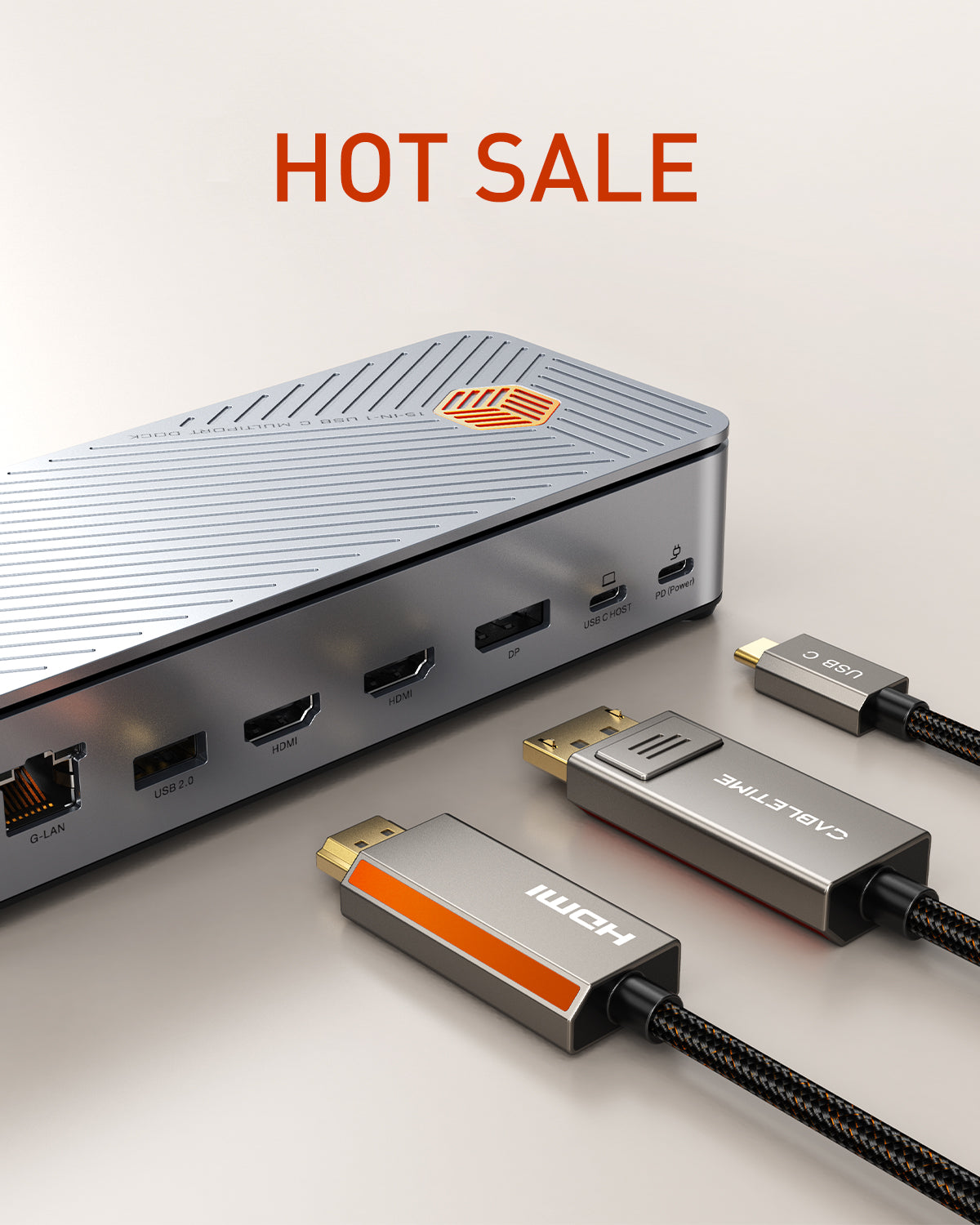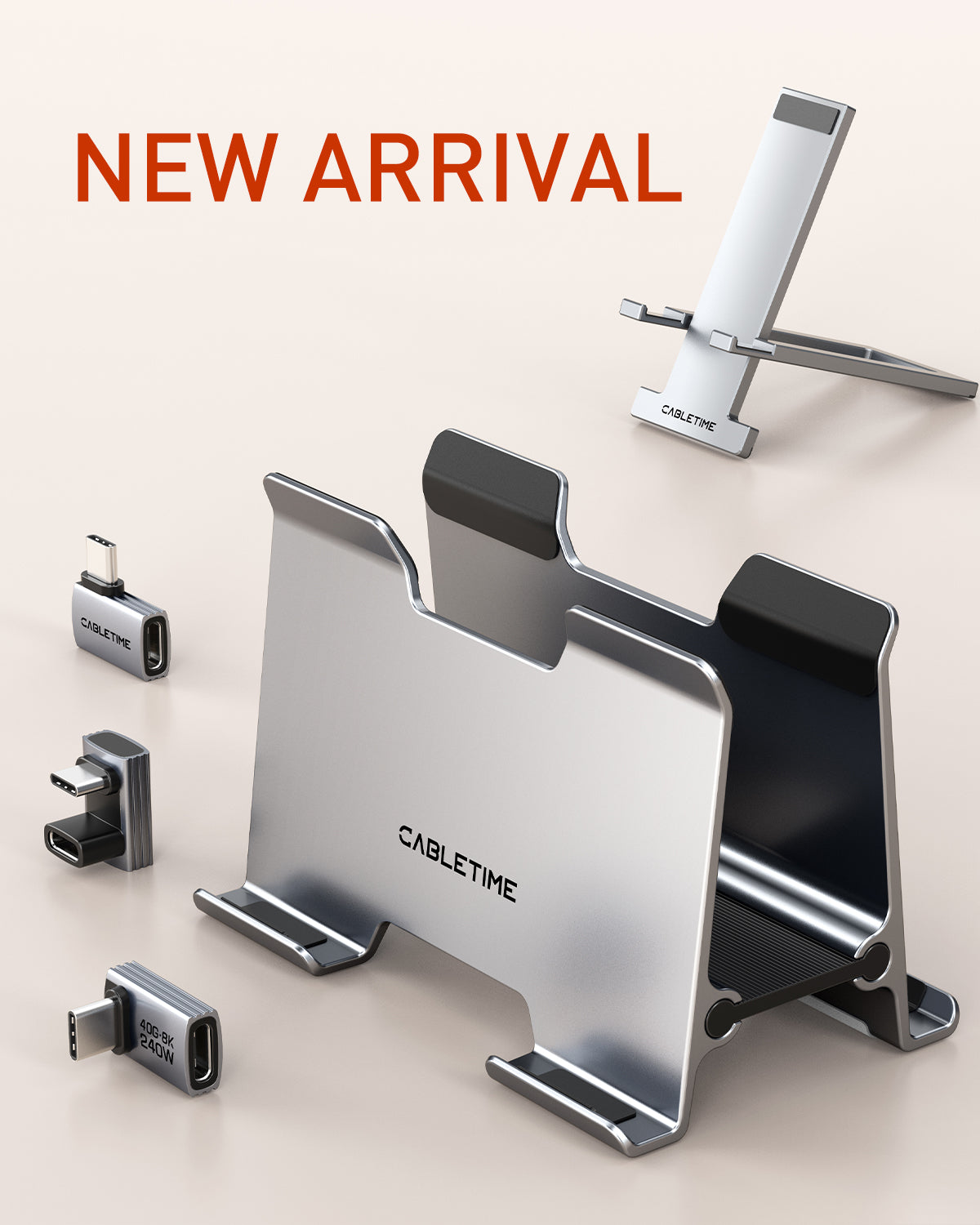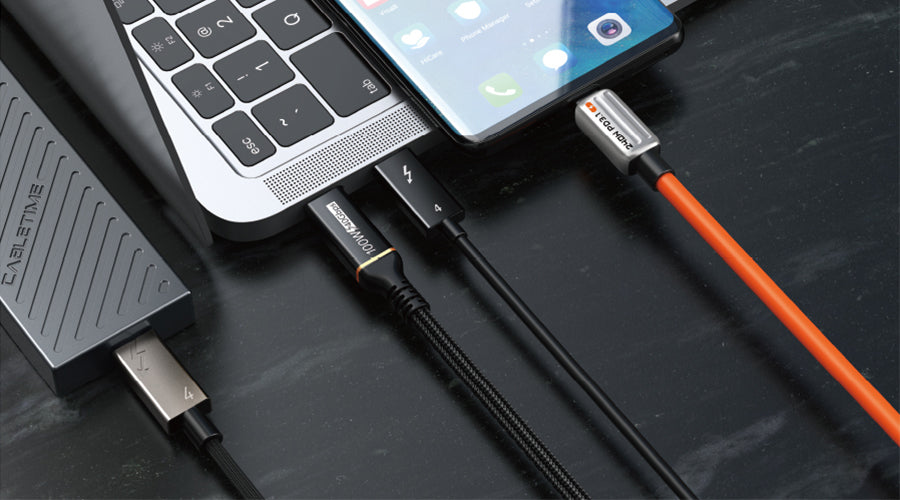I cavi audio sembrano semplici in superficie, ma in realtà c'è un'enorme varietà in termini di connettori, qualità di costruzione, metodi di trasmissione e compatibilità con vari componenti A/V. Questa guida svelerà le cose in modo che tu possa acquistare i cavi giusti per la tua attrezzatura.
Parleremo di tutti i tipi di cavi audio comuni, da quelli analogici a quelli digitali, quando li useresti e cosa cercare in un cavo di qualità. Immergiamoci!.

Indice dei contenuti
Cavi RCA

I cavi RCA, a volte chiamati connettori phono o cavi cinch, sono in circolazione dagli anni '40 e sono stati ampiamente utilizzati nei primi sistemi stereo domestici. I cavi trasmettono un segnale audio analogico e hanno uno schema di colori dei connettori rosso e bianco.
Pro:
- Economico e facile da trovare
- Compatibile con la maggior parte dei vecchi dispositivi audio analogici
- Connettori push-in facili
Contro:
- Soggetto a interferenze e degradazione del segnale
- Qualità audio limitata a causa della trasmissione analogica
- Spesso supporta solo l'audio a 2 canali (stereo)
Sebbene meno comuni nelle installazioni moderne, i cavi RCA trovano ancora impiego per collegare dispositivi come:
- Giradischi
- Lettori CD
- Registratori a cassette
- Videoregistratori
- Amplificatori/ricevitori più vecchi
- Alcuni televisori e dispositivi multimediali
Un consiglio quando si usano cavi RCA è di tenerli ragionevolmente corti, meno di 10 piedi se possibile. Questo evita interferenze e perdite di segnale. Inoltre impedisce che il cavo si sforzi su lunghi tratti, degradando il sottile percorso del segnale analogico.
Prestate attenzione anche alla qualità del connettore. Una fabbricazione scadente porta a un adattamento allentato nei jack, al taglio dei canali o alla necessità di muovere i cavi per funzionare correttamente. Ciò interferisce con la qualità del suono.
Tuttavia, per la maggior parte delle applicazioni, si consiglia di utilizzare cavi di tipo ottico o HDMI, se disponibili su entrambi i dispositivi collegati.
Cavi RCA consigliati da CableTime
| Cavo | Descrizione | Prezzo |
| Collega senza sforzo la porta da 3,5 mm del tuo laptop a dispositivi RCA come TV, amplificatori, altoparlanti e lettori DVD utilizzando questi cavi maschio da 3,5 mm a femmina RCA di alta qualità per un'esperienza audio migliorata. | $5,19 | |
| Cavo audio adattatore Y da 3,5 mm maschio a doppio RCA femmina | Collega facilmente la porta da 3,5 mm del tuo laptop a dispositivi dotati di RCA come TV, amplificatori, altoparlanti e lettori DVD con questi cavi di alta qualità da 3,5 mm maschio a RCA femmina per un'esperienza audio di qualità superiore. | $5,99 |
Cavi da 3,5 mm

Il connettore da 3,5 mm è uno standard di cavo mini-jack utilizzato in tutti i tipi di dispositivi audio moderni. Chiamato anche jack per cuffie, trasporta segnali audio stereo analogici.
I cavi da 3,5 mm sono onnipresenti e vengono utilizzati in cose come:
- Cuffie
- Cuffie telefoniche
- Altoparlanti portatili
- Lettori audio per auto
- Computer portatili, tablet e PC desktop
Pro:
- Il connettore compatto occupa uno spazio minimo
- Semplice trasmissione audio analogica
- Compatibilità quasi universale con i dispositivi audio
Contro:
- Problemi di durata dei giunti di collegamento nel tempo
- Il segnale analogico si degrada a lunghezze maggiori
- Limitazioni nel supporto dell'audio ad alta larghezza di banda
Se devi collegare cuffie o altoparlanti portatili, dispositivi come telefoni o tablet a un ingresso AUX o trasmettere audio analogico tra dispositivi del computer, un cavo da 3,5 mm è solitamente la soluzione più semplice.
Per una compatibilità ottimale, consiglio di acquistare cavi da 3,5 mm con:
- Giunti di collegamento rinforzati
- Conduttori in rame di alta qualità
- Schermatura adeguata per ridurre al minimo le interferenze
Come quelli offerti da CableTime:
Cavi da 3,5 mm consigliati da CableTime
| Cavo | Descrizione | Prezzo |
| Usa questo cavo aux ad angolo retto di 90 gradi per collegare il tuo iPad, iPhone o lettore multimediale a stereo per auto, stereo domestici o altoparlanti portatili. Compatibile con qualsiasi dispositivo con una porta aux da 3,5 mm. | $4,99 | |
| Questo cavo audio stereo maschio-maschio da 3,5 mm è compatibile con la maggior parte dei dispositivi da 3,5 mm, come autoradio, altoparlanti, smartphone e tablet, consentendoti di ascoltare la tua musica ovunque. | 2 dollari.99 |
Cavi XLR

I connettori XLR hanno tre pin e sono ampiamente utilizzati in apparecchiature audio professionali come microfoni, mixer, attrezzature da palco e apparecchiature di fascia alta per uso domestico.
Pro:
- Il segnale audio bilanciato resiste alle interferenze
- La qualità costruttiva robusta resiste all'uso intenso
- I connettori di bloccaggio impediscono che i dispositivi si disconnettano accidentalmente
Contro:
- Più ingombrante e meno comodo del 3,5 mm
- Richiede ingressi/uscite XLR per funzionare
- Generalmente più costoso
Se la qualità del suono è la tua preoccupazione principale, specialmente su lunghe tratte di cavi, XLR è la migliore opzione di connettività. I cavi trasportano segnali audio bilanciati, il che significa che usano due conduttori per trasmettere lo stesso segnale. Se si verifica un'interferenza esterna, il dispositivo ricevente può filtrarla confrontando i due canali.
Ciò rende i cavi XLR ideali per:
- Attrezzatura da studio di registrazione
- Sistemi PA
- Amplificatori e altoparlanti di fascia alta
- Microfoni
- Pianoforti digitali
- Attrezzature per la trasmissione
Quando si acquistano cavi XLR, si noteranno riferimenti a cose come XLR3, XLR5 e XLR6. Questo si riferisce al numero di pin nel connettore.
- 3 pin è lo standard per l'audio stereo bilanciato
- 5 pin supportano segnali di controllo stereo PIÙ aggiuntivi
- 6 pin estendono questo con doppie linee di alimentazione
Quindi non preoccuparti troppo di quei numeri. Abbina semplicemente i connettori alla tua attrezzatura e sarai a posto. Fai più attenzione alla qualità del cavo stesso: cerca una guaina esterna resistente e un cablaggio interno di grosso calibro che non si rompa con piegature e manipolazioni ripetute.
Scegli anche una lunghezza adatta alle tue esigenze. Non acquistare un cavo da palco da 100 piedi per un impianto microfonico da studio da 10 piedi: un avvolgimento eccessivo causa problemi.
Cavi XLR consigliati
| Cavo | Descrizione | Prezzo |
| Cavo standard per microfono | $8,77 | |
| Extra lungo, per uso in studio/spettacolo | $ 15,19 |
Cavi ottici (TOSLINK)

I cavi ottici, chiamati anche TOSLINK, trasmettono segnali audio tramite impulsi di luce anziché segnali elettrici. Ciò li rende ideali per inviare audio digitale tra dispositivi senza stadi di conversione analogici che potrebbero degradare la qualità.
Pro:
- Trasmissione perfetta del segnale audio digitale
- Immunità totale alle interferenze elettriche
- Supporta più canali audio
Contro:
- Richiede ingressi e uscite ottiche
- Raggio di curvatura del cavo limitato
- Connettori fragili
Grazie a questi vantaggi, i cavi ottici prosperano nelle applicazioni home theater. Quasi tutti i moderni televisori, ricevitori, streamer, lettori multimediali e console di gioco con connessioni audio digitali hanno porte TOSLINK. I cavi trasportano segnali multicanale, supportando formati audio surround avanzati come Dolby Digital e DTS.

I cavi ottici sono utili anche nelle configurazioni stereo più sofisticate, poiché isolano i componenti audio sensibili da qualsiasi interferenza elettrica, garantendo comunque un perfetto trasferimento del segnale digitale tra i dispositivi.
Bisogna solo fare attenzione a non superare il raggio di curvatura minimo e a non esercitare una pressione che potrebbe rompere le fibre di vetro interne o i giunti dei connettori.
Consigliamo i cavi TOSLINK di CableTime dotati di alloggiamento del connettore in metallo rinforzato e rivestimento in PVC flessibile:
Cavi TOSLINK consigliati da CableTime
| Cavo | Descrizione | Prezzo |
| Lunghezza standard, uso home theater | $3,59 | |
| Lunga corsa per stanze più grandi | $ 9,99 |
Cavi bilanciati vs. sbilanciati
Si riferiscono al modo in cui i segnali audio vengono trasmessi tramite cavi tra dispositivi:
Sbilanciato i cavi utilizzano un singolo conduttore per trasportare il segnale audio, con il percorso di ritorno condiviso tramite un comune filo di terra. Le connessioni sbilanciate sono economiche e semplici da implementare, comunemente utilizzate in cose come cavi per chitarra, apparecchiature di consumo e apparecchiature di registrazione di base.
Equilibrato i cavi sono dotati di due conduttori, uno per trasportare il segnale, l'altro per trasportare la sua copia invertita. Ciò fornisce una reiezione del rumore molto migliore poiché qualsiasi interferenza colpisce entrambe le linee in modo uguale, cosa che l'estremità ricevente può annullare. L'attrezzatura audio professionale utilizza connessioni XLR o TRS bilanciate poiché trasmettono segnali audio puliti su lunghe distanze.
Dovresti usare cavi bilanciati?
Se disponi esclusivamente di apparecchiature di consumo come telefoni, computer portatili o componenti stereo di base, i cavi RCA e da 3,5 mm non bilanciati andranno bene, poiché la lunghezza dei cavi è breve.

Per l'home theater, consigliamo di aggiornare i cavi HDMI non bilanciati o i cavi audio ottici. Ciò evita qualsiasi degradazione audio da interferenze elettriche, pur supportando l'audio multicanale. L'ottico fornisce un trasferimento digitale perfetto, mentre l'HDMI gestisce sia il video digitale che l'audio su un singolo cavo.
Chi possiede apparecchiature di registrazione professionali, amplificatori e altoparlanti costosi o cavi di collegamento lunghi trarrà vantaggio dai cavi XLR o TRS bilanciati:
Cavi bilanciati consigliati
| Cavo | Descrizione | Prezzo |
| Collegare il microfono professionale alla telecamera/mixer | $ 11,99 | |
| Estendi il percorso del segnale bilanciato | $8,59 |
Cavi audio USB
Con la marcia costante verso la connettività digitale, i cavi USB svolgono un ruolo sempre più importante nella trasmissione di segnali audio tra dispositivi. Gestiscono sia la distribuzione digitale che quella di potenza tramite un'unica porta compatta.
I moderni mixer, interfacce audio, altoparlanti, giradischi, tastiere e altri dispositivi ora dispongono di connessioni USB per integrarsi con computer e dispositivi mobili. I DAC USB ad alta risoluzione (convertitori digitale-analogico) consentono inoltre agli audiofili di riprodurre audio lossless su laptop e telefoni.
Pro:
- Compatto e comodo da usare
- Alimenta piccoli dispositivi come i DAC
- Abilita il controllo software dei parametri
Contro:
- Prestazioni limitate della lunghezza del cavo
- Può introdurre rumore elettrico senza un isolamento adeguato
Per sfruttare un audio digitale incontaminato evitando le insidie della connettività USB, cavi di qualità sono essenziali. Cerca cavi USB con:
- Linee elettriche e dati ad alto calibro
- Induttori di ferrite integrati per filtrare il rumore
- Rivestimento esterno in nylon o PVC resistente
Contribuiscono a garantire un funzionamento senza intoppi delle apparecchiature audio professionali, sia in fase di registrazione che di riproduzione.
Prestate attenzione anche alla versione USB: USB 2.0 funziona per l'interfaccia audio stereo di base, mentre USB 3/3.1/USB-C offre una larghezza di banda maggiore per l'audio multicanale e una latenza inferiore.
Consigliamo i cavi Cabletime che supportano l'ultimo standard USB 3.2 Gen 2x2 fino a 20 Gbps:
Cavi USB consigliati da CableTime
| Cavo | Descrizione | Prezzo |
| Questo cavo USB Type C a C offre un rapido trasferimento dati a 20 Gbps, espansione del monitor e compatibilità con USB 3.2, 3.1, 3.0 e 2.0. | 9 $.49 | |
| Cavo USB C a USB C ad angolo retto da 90 gradi 20 Gbps 100 W 4K | Migliora la tua connettività con il cavo USB C a C a 90 gradi di CABLETIME, che offre trasferimenti dati a 20 Gbps, ricarica da 100 W, uscita video 4K e maggiore durata. | $ 10,99 |
Conclusione
La rivoluzione dell'audio digitale ha aperto le porte a una varietà di standard e opzioni di collegamento via cavo. Sebbene ciò offra grande flessibilità, richiede anche un po' di competenza quando si collega un sistema audio per ottenere il suono migliore.
È fondamentale comprendere protocolli moderni come USB, TOSLINK e HDMI insieme alle opzioni analogiche classiche come XLR, RCA e 3,5 mm. Abbina i dispositivi in base ai formati supportati, ai requisiti di qualità e alle sfide di connettività.
Con i cavi giusti nella tua cassetta degli attrezzi, adatti a ogni sorgente e apparecchiatura di ascolto, eviterai problemi di compatibilità, perdita di segnale, rumore indesiderato e distorsione. Ciò consente ai bit digitali puri o alle calde onde analogiche di risplendere.
Speriamo che questa guida abbia fornito una solida base per demistificare i tipi e gli usi dei cavi audio. È il momento di collegare la tua attrezzatura e iniziare ad ascoltare!
5 domande correlate che i lettori potrebbero porre
- Posso utilizzare cavi RCA per segnali audio digitali?I cavi RCA solitamente trasportano segnali analogici, ma alcuni connettori RCA sono usati per l'audio coassiale digitale, che invia segnali SPDIF. Usa invece cavi ottici o HDMI per inviare audio digitale.
- Quali sono i vantaggi dell'utilizzo di cavi XLR rispetto ai cavi da 3,5 mm?I cavi XLR supportano la trasmissione audio bilanciata su lunghe distanze, riducendo notevolmente le interferenze. Sono costruiti in modo robusto per l'attrezzatura professionale.
- Come faccio a sapere se il mio dispositivo audio supporta i cavi ottici?Controlla se il tuo dispositivo è dotato di porte di forma rettangolare con una copertura a ribalta, probabilmente connettori ottici TOSLINK.
- I cavi bilanciati sono necessari per le installazioni audio domestiche?Di solito non per cavi più corti. Tuttavia impediscono che le interferenze rovinino la qualità man mano che i sistemi aumentano di dimensione.
- I cavi audio USB possono essere utilizzati con tutti i tipi di dispositivi audio?Le porte USB sono sempre più presenti su dispositivi, ma verifica sempre che i tuoi componenti siano dotati di porte host (per la connessione ai PC) o porte client (per la connessione AI PC).






Commenta
Questo sito è protetto da hCaptcha e applica le Norme sulla privacy e i Termini di servizio di hCaptcha.